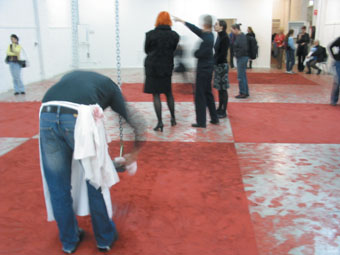Red requiem
Alan Schacher

Margaret Roberts, Red check (2004)
photo Jan Carter
Margaret Roberts, Red check (2004)
Margaret Roberts’ Red check closed the old Tin Sheds Gallery with a final, moving exhibition. Roberts’ practice focuses on the less than obvious aspects of architectural environments, and makes building/site and visitor movement/ interactivity integral to her artwork. Tin Sheds Director Jan Fieldsend writes that Roberts’ process is one of recognition and remembering. While the new space was being prepared, Roberts was simultaneously undoing the old gallery: re-touching surfaces, removing 40 spotlights, tracking and skylight covers, demolishing exhibition walls, returning the space to an earlier state. This unseen activity represented a dismantling of elements and meanings, a delving into perception that lies at the core of Roberts’ concerns. Here achieving an astute political sublime, she keeps a reactionary era in mind while returning the building to itself, removing the contrivances of trite gallery-ness, allowing something else to hover in that space between floor and roof.
From the seesaw to the swings that Roberts suspended from the rafters, and coat hooks installed along both walls, there was an eerie sense of absence suggestive of possibly sinister events. (In a schoolyard? The Old Darlington School lies just behind, a relic of a vanished local community.) Swinging and seesawing through such history, her trademark pigment powders marked out large red iron oxide squares over a grey painted floor. A throw of this mystic powder causes a through-the-looking-glass picnic cloth, a flag, a semaphore, a non-sense distortion to settle over the former garage floor. People who enter may or may not take up the invitation to swing, but still have no option but to leave evidence: footprints, scrapes, smears, as the oxide spread and it was no longer clear whether the floor underneath was red or grey.
Roberts says: “Opening night visitors went berserk, disintegrating the checks—red went walking out of the building like the long-past left wing politics of the 1960s and 70s: shifting red sentiment to red sediment.” A comment on the passing on of a tradition at the Tin Sheds, Roberts speaks of loss, death, disappearance. “The red of the checks is like blood or tears. It’s an invitation to the public to jump in and make a commitment.” She reflects: “How do you document site-specific art, where the main thing deleted is the site itself?” Here, where the erasure of site will be doubly final, she provided cameras as a means for the public to record traces of their visit.
Roberts, a lap-swimmer, also modelled the installation on her local pool’s change-rooms: 13 white handtowels hanging on dowelling hooks (she notes one towel disappeared). Towels to wipe hands or feet, to clean walls, and disposable cameras to document the chaos. People’s soiled shoes carried imprints of the artwork and traces of the disappearing gallery out into the street beyond and on to the new space in the Wilkinson Building (School of Architecture, University of Sydney): a bloody analogy, murder or transfusion? Alongside the cameras the towels also gathered imprints, tiny shrouds, dry, blood-stained. To the side a small white storeroom was staffed by 3 attendants on the opening night, wearing aprons, wiping and removing pigment from visitors’ shoes, reverential, biblical, yet futile. These cloth traces remain, recent relics placed on shelves, a photo-archive.
The change-room was an analogy for social change, but not always for the best. Good intention and commitment are sometimes lost and defeated in the process of evolution. Margaret Roberts perhaps alludes to a slower world, but also to a grim past, to death camps and gas chambers, a final solution, giving up: “Take your clothes off, take a shower, swing and die.” Red check, as an action for and by the public, was ultimately a requiem, not a celebration: it put bodies, place and memory into the whirling mixing-bowl of history, and strewed the batter up City Road.
Margaret Roberts, Red check, Tin Sheds Gallery, University of Sydney, June 11-July 3
RealTime issue #63 Oct-Nov 2004 pg. 52






